November 24, 2005
Self-Conscious and Independent:
An Exploration Into and Out of the
Limit Conditions of Science Education
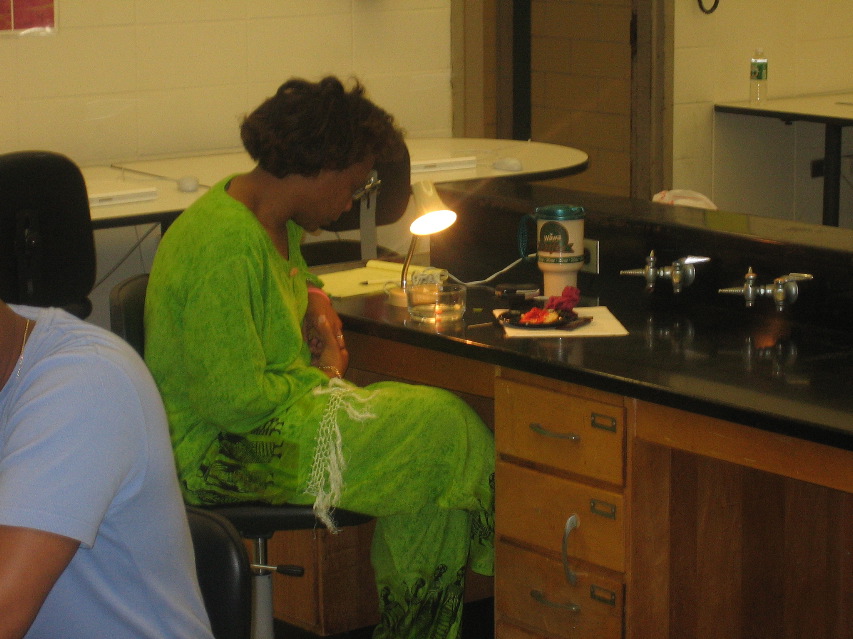 | 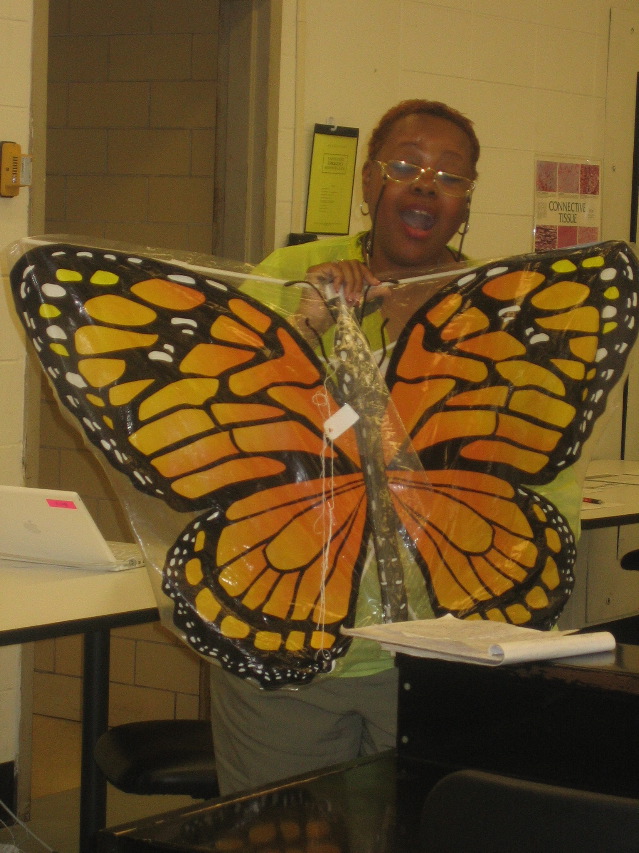 |
 |  |
We are a literary critic and a biologist who--with great good will and a lot of energy--took on together this challenge of making the practice of science more accessible to, and inclusive of, a wider variety of people. In the summer of 2005, we co-directed an Institute for K-12 public school teachers supported by the Howard Hughes Medical Institute. We called our project, which was hosted by Bryn Mawr College, and is fully archived at http://serendipstudio.org/local/suminst/eei05/, "Making Sense of Change: Hands-on Science Across the Curriculum." Our group was quite varied in terms of preparation and engagement: some of the participants had very little science background; others had masters' in science education. They themselves taught classes spanning kindergarten to high school. Some of them were long-time veterans of earlier Institutes sponsored by the College, while others had no such experience. Some thought of change as "an old friend"; for others it was a "challenge," "terrifying," to be avoided in a search for what was stable and lasting.
What we uncovered, in working with these teachers, is an understanding of how and why contemporary science education--the progressive, innovative, hands-on, inquiry-based classroom science of the past decade, which has been so deliberative in its attempts to bring those traditionally "outside" science "into" its various fields--has fallen short. It will be the argument of this essay that attempts as well-intentioned and well-funded as our own have failed to take account of a central facet of human psychic and economic development: the Catch-22 of the persistent human impulse to put oneself "out," to refuse incorporation into any system that presumes to "know" or "predict" the direction of self-growth.
The articulation of this great irony, that the act of recognition is always an act of "determinateness" and "fixing," and thus will always be resisted, goes back at least as far as Hegel's 1807 essay on "Lordship and Bondage." It has been updated repeatedly in ethnographic work on education, perhaps most cogently in Paul Willis's 1977 study, Learning to Labor: How Working Class Kids Get Working Class Jobs. Willis demonstrates that the "lads" in his study "disqualify themselves from the middle class," "self-produce themselves as workers "by defining themselves, in antagonism, as others of bourgeois culture (xii). In "The Romance of Resistence" (1989), another ethnographer, Lila Abu-Lughod, articulates the central problem with such an approach: "If the systems of power are multiple, then resisting at one level may catch people up at other levels." (Her example is Egyptian Bedouin women who free themselves from the control of their mothers-in-laws by becoming more directly and narrowly dependent on their husbands. In the name of increasing freedom, the women are "backing in" to new forms of subjection.)
But Hegel's essay also provides, presciently, a cogent analysis of how a student might move out of the sort of "self-damnation" that Willis laments (3), beyond the seemingly inevitable stand-off between recognition and resistance: "precisely in labour where there seemed to be merely some outsider's mind and ideas involved, the bondsman becomes aware...of having and being a 'mind of his own.'" During our work with the Philadelphia teachers, we recovered two Hegelian insights. First: it doesn't matter how "out"--how expansive--the inside is. As the "outside" is incorporated into the inside, another outside is always generated alongside. (As Stanley Fish says so clearly in a larger pedagogical context, difference is "the remainder that escape the drawing of any line, no matter how generous...the lesson [is] its irreducibility"). We also found that, precisely by participating with our students in that "dance of the irreducible," we were all enabled to engage--at first with difficulty, and fitfully, but eventually quite productively--in what Hegel calls the "formative process of self-enfranchisement." We structure this essay, accordingly, around a sequence of scenes from our summer's classroom, scenes which illustrate, qualify, re-arrange and extend the stages Hegel articulates in The Phenomenology of Mind: those of mutual recognition, opposition, consciousness, labor, and self-enfranchisement. The dialectic we have to trace is complicated but finally, progressive and hopeful.
The best of our classes, we came to see, did three things: addressed a topic which interested the participants (and which they thought would interest their students); framed it in terms of big questions and profound issues; and demonstrated it in concrete manipulatable experiences--not as experiments in the conventional sense of scripts to be followed, but as open-ended explorations. Taken together, the ten days of the Institute proved a model of interactive science teaching, meeting the challenge described in Science as Story Telling in Action of moving toward science that is
The account we offer here of how we made sense of what didn't work in the Summer Institute on "Making Sense of Change" is framed, in other words, in the context of a great deal that did. Our exploration of change had a few key structures. The two of us were present for every session during the two-week period; we met at the end of each day to review what had worked, what hadn't, and to plan follow-ups for the following sessions. We set up each half-day session with introductory lectures and activities, and concluded each one by requiring participants to record and reflect on their experiences in a web forum. We supplemented our own presentations with those of guest teachers. Visitors included a physicist, a geologist, a chemist, a biologist, a psychologist and a computer scientist. This arrangement provided us with a rich opportunity for expanding our own education in science education; for six hours every day, we were able to observe what worked and what didn't, how hands-on learning engaged the teachers, and what happened when they weren't engaged. But since it is in the places where we fall short that we all have the most to learn, we focus our attention, here, on those. To begin in the beginning....
We chose as our theme the dynamic interaction of "constancy built on change." We opened the Institute with the image of the faulted shale-limestone block which sits outside the Bryn Mawr Science Building, in commemoration of the founding of the Department of Geology here: an ironically "solid" record of historical pressure and stress. We spoke in the first session about our own--markedly different--relationships to constancy and change. (One of us was raised in a stable, somewhat stultifying, environment, and found herself drawn eventually into science education because of its unremitting skepticism and openness to new possibility. The other of us was raised in an unstable, and unsettling, place, and found himself drawn early to science because of its ability to elucidate patterns that were constant and predictable.)
As we concluded our opening presentation, we asked participants to write on-line, and then to read aloud to the group, a short story about some change they made--or chose not to make--in their teaching or learning or life. One of the teachers refused to read her contribution to the group: "We are not children. Adults don't like to be read to, and I try to respect what people want." Her refusal to perform publicly her own relationship to change was our first indication that our attempts to gather all participants into a single story--however commodious, however complex and paradoxical--were going to be continually met with resistance.
At this point, we weren't sure why. We knew, from past Institutes, that participants valued the respect they earned as our colleagues; they liked seeing that they had a great deal to teach us. Following Hegel (although at the time we didn't realize we were following Hegel) we expected that, this time 'round, we would all recognize ourselves "as mutually recognizing one another." What we had not realized was Hegel's further insight--that the initial move in this game involves an instinctive reaction to others as antithetical to our own self-fulfillment, opponents or competitors with us in the game of recognition; as he says, "self-consciousness is primarily...self-identity by exclusion of every other from itself." When we first tried to draw a circle that included all participants, one of them immediately excluded herself.
I. Self-Cancellation
|
All that you touch You Change. All that you Change Changes you. The only lasting truth Is Change God Is Change. Octavia Butler. "Earthseed: The Books of the Living." Parable of the Sower (1993) | 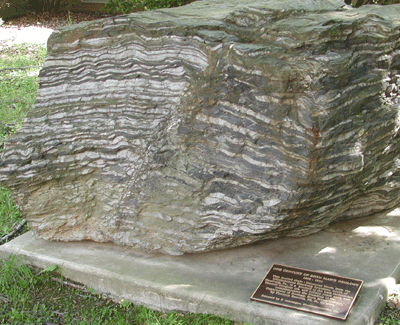 | "The only lasting truth is Christ. Therefore, on Christ, The Solid Rock, I stand. God is not change. He is stability....God always was, is, and will be. God is stable. Change is constant." Miss T. (Public High school principal and participant in Summer Institute) |
We were reminded, during the initial hours of the Institute, of the desire of all humans to be free, the desire, even of teachers, to reclaim from the structure of a school day what Willis calls "principles of mobility and self-direction" (27)--if only by coming late to a session, or checking out in the rear of the room, by playing a game of computer solitaire. Trying to "integrate" all the participants into our lesson plans, we found them "differentiating" (Willis's terms, again, 63), critically separating "self" from the institution of education, holding in reserve that which they were determined to keep "private" (65). It occured to us that this reservation, this oppositional construction of self, might well be proportional to the unfamiliarity of the topic. Where is the self in the Big Bang and quantum patterns of mass and energy?
We had planned deliberatively for our initial class on cosmology, with an awareness of and eagerness to know more about where Institute participants were "coming from." We had asked all of them, before they arrived on campus, to post on-line an account of how they would go about describing the beginning of the universe to their class or to to their own children at a certain age: How would they get started? How would they tell the story? What would they emphasize? But the first morning's presentation on cosmology seemed not to speak to the participants; it had many of them "getting lost in the stars"; one observed that she "would still need more information on how to apply this difficult topic....I would have some difficulty bringing the language down to a middle or even to an elementary level"; another observed "that these topics are quite interesting for those who already inclined to study the space sciences. But for those who only possess a passing interest, these topics may be a little too abstract. The techniques for measurements that support what we are learning in this area are perhaps equally too advanced."
Not until the afternoon session were we able to make these concepts engaging to participants: cosmology that was experiential as well as observational, interactive as well as visual, ways they might ask their students to move their own bodies, or other manipulatable objects, which would help them understand--and in turn, teach--about the acceleration of bodies through space. The three activities we used in the afternoon all involved careful observing, and recording of observations, of
And what were ways of engaging their teachers and principals, some of whom had already "checked out" of the Institute before the end of the first morning session?
Hegel explains rather quickly that the second move in the game of recognition--destroying others to affirm ourselves--is contradictory: a person whom we have destroyed (or, less violently, dismissed) is not capable of giving us the recognition we seek, so we instinctively move to another strategy. We try to locate ourselves "on the inside," with the other decidedly "out" of it (or, in Hegel's terms, with ourselves on top, the other beneath us). In retrospect, it seems that this may well have been the dynamic which underlay both the second and third days of the Institute. Our guest on day two was an experienced chemist, who had offered many workshops for K-12 teachers, and prepared a booklet of hands-on experiments suitable for use with middle schoolers. She carefully guided participants through scripted activities, with predictable outcomes (turning a copper penny into "silver," then "gold"; inflating balloons with carbon dioxide; measuring the effect of an acid solution on marble chips). The roles of leader and followers, teacher and students, were clearly differentiated. We collected data, but interrogated none of the terms of the experiments we were conducting.
In the course forum afterwards, questions arose about the usefulness of such scripted experiments, in light of some interesting general issues about education:
On that day, a psychologist (who also had a lot of experience both teaching elementary school and working with K-12 teachers) visited our classroom, to show us how behaviorists, following the principles of reinforcement, can "guarantee" a change in behaviors. She explained first that developmental psychologists don't know much about how change happens (they have no idea, for instance, how Theory of Mind develops, how kids make the shift from thinking that others know what they know, to realizing that they may be thinking differently). She then defined the concepts of "reinforcement" (anything that will increase the likelihood of a behavior; teachers are not very good at predicting what is reinforcing for a younger generation) and of "extinction" (taking away the reinforcer). She also explained that "rebound" is to be expected (the behavior will "spike" before it ceases), and identified the usual failure of punishment (the opposite of reinforcement: actively decreasing the frequency of a behavior): not replacing the unwanted behavior with "something else."
With this presentation, our colleague intended to offer participants some useable tools for managing student behavior in classrooms where behavior is often a problem. But the teachers' own resistance to taking up these "tools" was universal--and nearly deafening:
Throughout these responses, we heard a vociforous insistance on what one of our lecturers once called "The Harvard Law of Animal Behavior": "under carefully controlled experimental circumstances, an animal will behave as it damned well pleases." Our participants were rejecting some of the useful techniques behaviorism might offer them for classroom management, in order to retain--both for themselves and their students--the sort of "intrinsic variability" which Fyodor Dostoevsky described so strikingly in Notes from Underground in 1864:
II. The Self in Labor
|
EFFECT OF ACID RAIN ON MARBLE STATUES This is an example of ... one of the two most common forms of chemical reactions. In an acid/base reaction an acid gets neutralized by a base to form water and a salt. The acids are usually easy to identify as they have a low pH in water, and their chemical formula always has at least one "H". Bases are harder to identify without knowing a lot more chemistry. The most common base is hydroxide ion -OH which is found in drain cleaning products like "Drano" or "Red Devil." In this reaction the base is the carbonate ion, CO3-2. It reacts with H+ of acetic acid to form carbonic acid, H2CO3, which mostly turns into carbon dioxide and water. In this experiment our purpose is to demonstrate the effect of acid rain on limestone, a major constituent of marble. (From Terry Newirth, Hand-On Science and Math: A Collection of Lesson Plans for Middle Schools) |  |
I enjoyed measuring and being methodical. Our children thrive off specific clear directions. By modeling appropriate techniques the students will increase their knowledge and the importance of being careful and specific. Connie Williams, Institute participant ...we return to the experiment format with expectated results. My poor brain is smoking!!!!!! How can the concept of getting it less wrong translate to experimantation and safety rules? Are we as teacher setting ur kids up to be afraid of science and afraid to get it wrong? What happens to creativity and facilitated, gradually scafoldded discovery?...I feel that today's lab return us to the correct answer, experiment format. HELP!!!!!!!!!! Is this what it feel like to our students to move from a more abstract style techer to a more linear, conservative style teacher?????????? Antoinette Solimon, Institute participant
|
The teachers' refusal to be defined by others' intentions, their refusal to perform within the framework of the scripts written by others, even when given the option to vary and revise those scripts, was repeated several times during the second week of the Institute. It was particularly noticeable in the responses to a session Wil offered, called When Caterpillars Make Choices. Participants took what they were learning about the instinctual behavior of caterpillars as a challenge to their own notions of free will, to their commitment to their own freedom, and to that of their students. They reported that they always offered their students choices:
The teachers strongly resisted what they understood to be an implication of behavorism: that they were responsible for their students' behavior. They countered that resistance with an insistence on helping their students take responsibility for their own behavior, with a conviction that, as agents, they must acknowledge the consequences of their actions. The cost of doing so is a less controlled classroom environment, but defining the self takes some practice, with lots of room for mistakes--a lesson, they eventually decided, well worth the risk.
III. Self-Enfranchisement
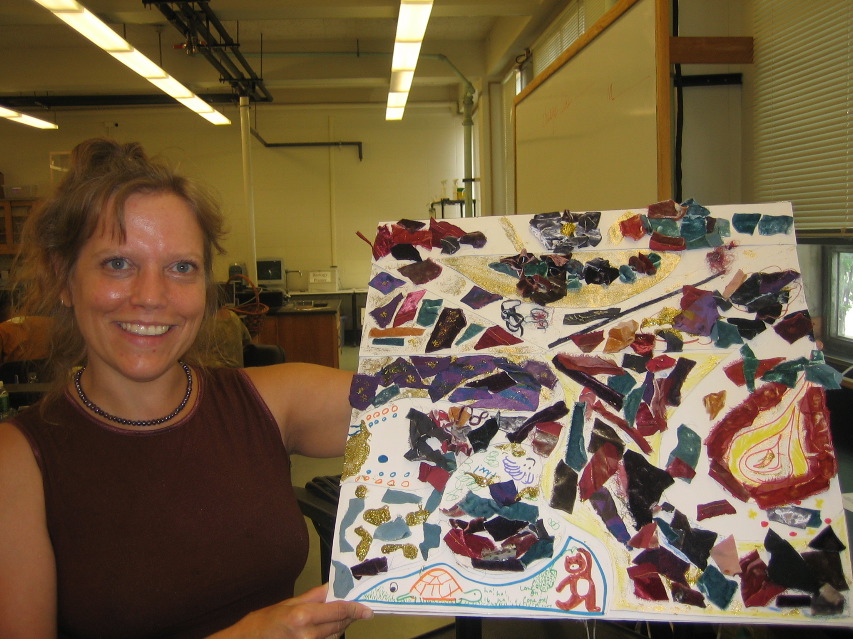 | What is choice? A change taking place. What is choice? Acting outside a set of instructions. | 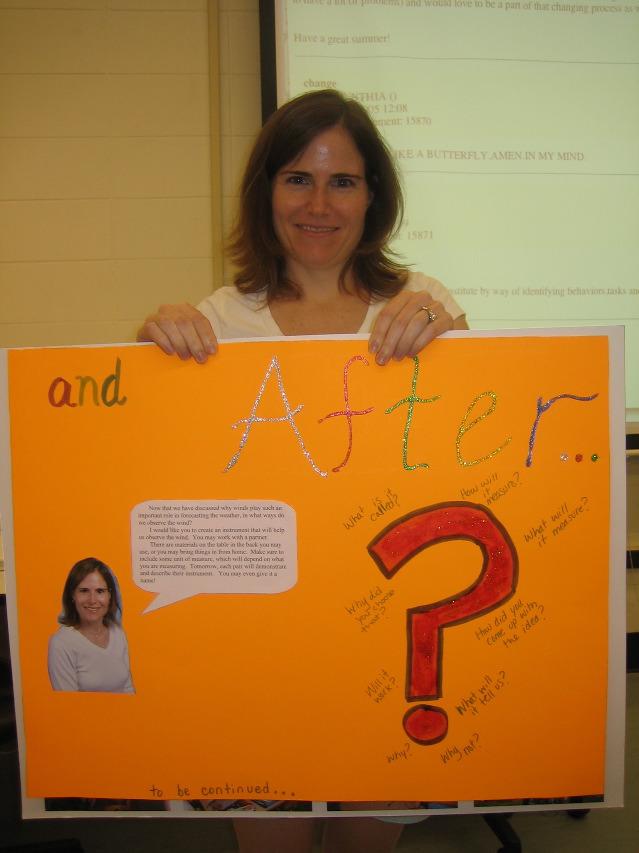
|
The most important "turn" in Hegel's essay occurs when he explains that the strategy of one-way recognition is misguided: the master depends entirely on the slave for her recognition as master. The slave is actually in a better position, as far as possibilities for development are concerned, because he is able to express himself in the world, by means of his labor. Slaves learn self-recognition, and self-enfranchisement, not in response to those who tell them what to do (and not to do), but in the work that they perform. They are capable of acting in, and on, the world, of being productive. In that productivity, they find themselves mastering the world. (Willis demonstrates this in the 20th century, as he traces the movement of working-class "lads" from the classroom, where they are purely oppositional, to the shop floor, where they are engaged in production.)
It seemed to us that precisely this phenomenon--actively contributing to the data-gathering and observation-making that is the work of science, and to the pedagogical innovation that is teaching students to do the same--would enable our participants to move beyond the conventional "resistence" that so many students demonstrate in relationship to their teachers. The classes which succeeded best were certainly those in which participants were asked, not to attempt replicating an experiment in which the results were already known, but rather to gather data for new ways of organizing the world. Through such labor, they were laying the foundation for what Hegel calls "formative self-enfranchisement."
They flourished, for example, in the "evolution revolution" designed for them by a colleague in biology, who asked them to sort and classify a wide diversity of life forms, according to schemes which made sense to them. They were able to acknowledge the validity of the organizing patterns they themselves had designed. Another colleague in geology helped them to understand the complexities of "global change" by asking them to describe what they knew, experientially, about what happens in their classrooms: What causes changes in students' attention spans? What happens if a perturbation--a distraction--occurs? Recognizing how their classrooms worked as systems, they were able to extrapolate to the complex interactions underlying climate change, to see how small changes in one area could have very large effects in another. Another colleague in computer science used "water-based computation" (in which cups of water were poured onto a free-swinging aluminum sheet) and the computer program "Alice" (an object-based way to teach the properties, methods and functions of computing). These activities helped participants move from computer "literacy" (having some skills with a set of applications) to "fluency": "getting the concepts behind the applications, being capable of applying these skills in various contexts." All of these exercises were composed of multiple trials and errors, with plenty of time and space for asking questions about what was working (or not), and why (or why not).
We ended the first week of the Institute with a mini-symposium, during which the K-12 teachers talked about their schools and classrooms; college and university administrators talked about the various collaborative possibilities they had to offer; and the groups talked together about how they might better communicate with one another about needs and resources to meet them, about home and school functions, about ways to engage students and widen their horizons, to see them as more than students. We discussed the high turnover rate among urban teachers, and the need for more education in both classroom management and parent/teacher relationships. We talked about opening up our classrooms, to one another, to the world, making them less private, more public--and revisable.
This morning was an important one, both in the trajectory of the Institute and in our understanding of what was working (and not working) in our shared exploration. The discussion among K-16 educators clearly marked a move out of definition of self in opposition to "other." Recognizing multiple possibilities for collaboration, resisting the impulse to dismiss those with deeper pockets and more resources, participants engaged eagerly in a series of acts of self-enfranchisement. During the second half of the Institute, this meant a further series of activities in which agency was increasingly enacted.
For instance, one theme sounded repeatedly during the morning's symposium was the discomfort of many parents with their children's schools. We looked further, that afternoon, at the ways in which changes in teaching and changes in students can lead to uncomfortable changes in the family and community. In lieu of a course in "methodology" or "applied psychology" (which one of our participants suggested teachers needed, in order to learn how to communicate with parents), we did some role-playing. Wil and Anne performed the scene from Brecht's play Galileo, in which one of Galileo's assistants, the "Little Monk," explains that he is giving up astronomy for the sake of his parents' peace of mind:
IV. Turning Inside Out: Performative Assessment
 |
"Chemistry: the satisfaction of making something happen that should, vs. the surprise of something happening that shouldn't." "Science: to see what has not yet been seen, to conceive what has not yet been conceived." (From Science as Storytelling in Action) | 
|
One of our participants, Randal Holly, observed that "standardized tests are thought to be most effective. There is no way of assessing such inquiry-based education." We took Randal's observation as a description of a possibility (as he also said), "not as a barrier, but an opportunity for the agent to interact with its environment, to change its environment." Accordingly, on the last day of the Institute, we asked all the participants to perform what had changed for them in the course of the program. We were inviting them, thereby, to experiment with "performative assessment": How could they demonstrate what they had been learning and doing, and what they would go on to do with it? This was an opportunity to observe how participants situated themselves in relation to new experiences. Did they take in the new information, negate it (in Hegel's terms), to "sublate" it? Did they recognize themselves in the projects we gave them, re-define themselves through their labor in the world? Could they imagine doing this with their students?
What was most remarkable to us, in these performances, was their range; there were poems and songs, collages and new lesson plans. We want to highlight just two here, the first designed Judith Odom, a middle school chemistry teacher; the second by Randal, who is a high school biology instructor.
The Cheese Ball Solvent, Solute, and Solution
Both of these lesson plans "sold themselves," by beginning with something the students already liked--cheese balls, science fiction films; by easing them into experience; then teasing them into understanding. The second lesson plan is also distinctive in giving credit both for "unlearning"information (that is, for the correction of error), and for knowledge already possessed before the class began. "Breaking the boundaries of science education," in both of these instances, did not involve "bringing the outside in" (inviting the children who feel disenfranchised to participate in a professional activity available only to specialists). It entailed rather turning the "inside out," by stepping into the children's world, and helping them make sense of it.
V. Concluding: Changing Some Presumptions about Universal Science Education
 | "...we ourselves are the things we can most easily change,
and so changing ourselves is the quickest and easiest way to get things less wrong." (One of the instructors in the Institute) "This Institute is different from other professional development workshops. We're not just learning isolated lesson plans. Everything fits together." (One of the participants in the Institute) |
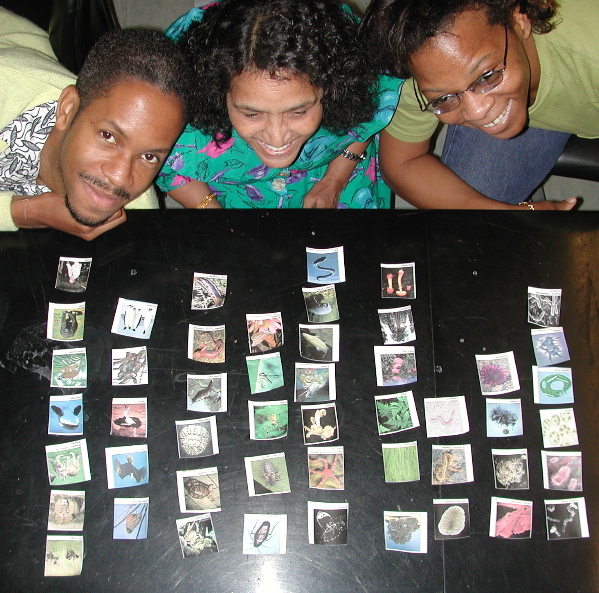 |
In designing the Institute, we were guided by a (contradictory? paradoxical?) vision of "constant change"-- from cosmology to computers, from the largest scale to the smallest, from the most profound to the most technical, from the earliest to the most recent. We wanted to explore with a group of interested teachers both ways of stabilizing what we know ("making it sticky") and the inevitability of change ("without getting stuck") on every imaginable level: cosmological, geological, chemical, biological, ecological, psychological, literary and technological. What we hadn't quite prepared for, though, was (we now see) the inevitable resistance to change of all the participants--ourselves, themselves, our students, their students--as well as our own fierce attachments to habitual ways of seeing and interacting with the world.
We learned a few other hard things during the course of the Institute. For instance, we heard teachers say that
As we came to understand during a subsequent discussion of Stories of Teaching and Learning, students will be changed by our exposing them to different ways of thinking and exploring the world. Whatever our intent, we become significant causal agents. And yet we cannot control the outcomes of these interactions. The consequences of creating open, individualized classrooms can be quite disruptive. Students may well respond with withdrawal, or resistance, or rejection of the invitation to construct their own meaning. To be complacent about this matter is to risk losing our most defiant students.
Like the participants in the Institute, we struggled continuously with how to engage students who were insistent on defining themselves as outsiders. Invited to demystify science, to define reality, to be "lords" (in the Hegelian sense), many teachers and students will decline, opting instead for the role of "bondsman." We have come to see that this may well be an important stage in becoming more fully ourselves. But it cannot be the final one. Excluding oneself only goes part-way. As Hegel, Willis and Abu-Lughod show, it is eventually a partial and not very productive way of defining oneself.
Another way to do so is to labor in the world, to engage it and act upon it. Our experiences in the Institute showed us that change that is chosen is more meaningful than change that is imposed. We believe that, in the long run, the more people can think and work for themselves, the more they will flourish. We used the Summer Institute to maximize such possibilities. We see the teachers' task as inviting students into engagement with a topic, encouraging them in mutual recognition, opposition, consciousness, labor, and from that, self-enfranchisement--in order to become more fully who they want to be, both within and outside of science education.
Making Sense of Change: Summer Institute on Hands-On Science
Working Group on Emergence